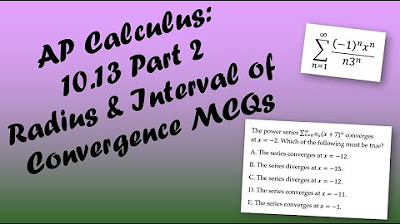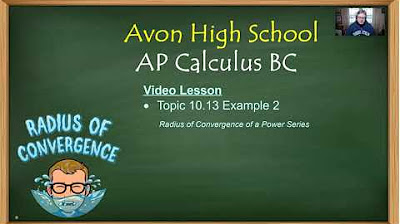Power Series - Finding The Radius & Interval of Convergence - Calculus 2
TLDRThis video offers an in-depth exploration of power series, explaining their structure and how to determine their center. It covers the crucial concepts of radius and interval of convergence, utilizing the ratio test for analysis. The presenter works through multiple examples to demonstrate how to apply these concepts, providing a clear understanding of when and where power series converge, including checking endpoints for convergence. The tutorial is designed to equip viewers with the skills to tackle problems involving power series effectively.
Takeaways
- 📚 Power series are infinite series with a variable x raised to the power of n, representing a function as the sum of its terms.
- 🔍 To determine the center of a power series, look for the value of 'c' or set the expression inside the series equal to zero to solve for x if 'c' is not explicitly stated.
- 📐 The radius of convergence and interval of convergence are key concepts for understanding where a power series converges, and the ratio test is used to determine these.
- ⚠️ If the ratio test limit is zero, the series converges for all x values, indicating an infinite radius of convergence and an interval from negative infinity to infinity.
- ⛔ If the ratio test limit is infinity, the series only converges at the center 'c', with a radius of convergence of zero and an interval consisting solely of the point x = c.
- 🔄 For other outcomes from the ratio test, the expression obtained is manipulated to find the radius of convergence 'r', and the interval of convergence is determined by the range of x values for which the series converges.
- 📉 The series may converge at the endpoints of the interval, and these must be checked using specific tests to confirm whether they are included in the interval of convergence.
- 📈 Examples provided in the script illustrate how to apply the ratio test to various power series and determine their radius and interval of convergence, including handling special cases where the series only converges at certain points.
- 📝 The script demonstrates the process of simplifying the ratio test expression, dealing with absolute values, and setting up inequalities to find the interval of convergence.
- 📌 Checking endpoints is crucial as it can affect whether the interval of convergence is open or closed at those points, using tests like the divergence test and the alternating series test when necessary.
- 📊 The final step is to plot the interval of convergence on a number line, indicating whether the endpoints are included with open or closed circles, and understanding the significance of the center 'c' and the radius 'r'.
Q & A
What is a power series?
-A power series is an infinite series where the variable x is raised to the power of n, and it can be centered at a point other than zero.
How can you determine the center of a power series?
-The center of a power series can be determined by looking for the value of 'c' in the expression x - c, where 'c' is the center. If there is no 'c', the series is centered at zero.
What is the purpose of the ratio test in the context of power series?
-The ratio test is used to determine the radius of convergence and the interval of convergence of a power series.
What are the three scenarios that can result from the ratio test for a power series?
-The three scenarios are: 1) The limit is zero, indicating convergence for all x values with an infinite radius of convergence. 2) The limit is infinity, indicating divergence for all x except the center 'c', with a radius of convergence of zero. 3) The limit is a value that depends on x, leading to a finite radius of convergence and a specific interval of convergence.
How do you find the interval of convergence for a power series?
-After finding the radius of convergence using the ratio test, you determine the interval by adding and subtracting the radius from the center 'c'. Then, you check the endpoints to see if they are included in the interval of convergence.
What is the significance of checking the endpoints in the interval of convergence?
-Checking the endpoints is important because the series may converge or diverge at these points, which affects how the interval of convergence is expressed (using parentheses or brackets).
Can a power series have a radius of convergence of zero?
-Yes, a power series can have a radius of convergence of zero if the series only converges at the center point 'c' and diverges for all other x values.
What does it mean if the ratio test result is less than one?
-If the ratio test result is less than one, it indicates that the series may converge, but further analysis is needed to determine the exact interval of convergence.
How can you determine if a series converges at a particular endpoint?
-To determine convergence at an endpoint, you can substitute the endpoint value into the series and apply tests such as the divergence test or the alternating series test.
What is the role of the absolute value in the ratio test expression after simplification?
-The absolute value in the ratio test expression ensures that the inequality holds true for all values of x, accounting for both positive and negative deviations from the center 'c'.
Can you provide an example of a power series that converges for all x values?
-An example of a power series that converges for all x values is the series from zero to infinity of x^n over n factorial, which has an infinite radius of convergence.
Outlines
📚 Introduction to Power Series
The video introduces the concept of power series, explaining them as infinite series with a variable x raised to the power of n. It distinguishes between series centered at zero and those centered at a different point c. The importance of identifying the center of a power series is emphasized, with examples provided to illustrate how to determine the center for various series.
🔍 Determining the Center of Power Series
This section focuses on how to determine the center of different power series, using specific examples. It explains that if no center is explicitly shown, the series is centered at zero. The video provides a method to find the center by setting the inner expression of the series equal to zero and solving for x. Examples include series centered at c=2, c=-4, and c=2/3, highlighting the process of solving for x to find the center.
📐 Understanding Radius and Interval of Convergence
The video moves on to discuss the concept of radius and interval of convergence for power series. It explains the use of the ratio test to determine these, involving taking the limit as n approaches infinity of the ratio of consecutive terms. The video outlines three scenarios based on the outcome of the ratio test: convergence for all x values (radius of convergence is infinity), divergence except at a single point (radius of convergence is zero), and convergence within a specific range of x values.
📘 Applying the Ratio Test to Power Series
The paragraph demonstrates the application of the ratio test to determine the radius and interval of convergence for given power series. It shows step-by-step calculations for series such as x^n/n! and discusses the implications of the ratio test results, including the convergence for all x values and the identification of the interval of convergence.
🔑 Key Examples of Power Series Analysis
This part of the video script provides detailed examples of applying the ratio test to specific power series, such as n! * x^n and others. It explains how to simplify the expressions and interpret the results of the ratio test to find the radius and interval of convergence. The examples illustrate scenarios where the series converges only at a single point or for all x values, and the corresponding intervals of convergence.
📌 Checking Endpoints for Convergence
The video script emphasizes the importance of checking the endpoints of the interval of convergence. It explains that even if an interval is determined, the endpoints may not always be included in the convergence. The script provides examples of how to test the endpoints using the divergence test and the alternating series test, and how to adjust the interval of convergence accordingly.
📈 Plotting the Interval of Convergence
This section discusses how to graphically represent the interval of convergence on a number line. It explains the use of open and closed circles to indicate whether the endpoints are included in the convergence. The video provides an example of plotting the interval for a power series centered at one with a radius of convergence of one.
📝 Final Examples and Summary
The final part of the script presents additional examples of power series, applying the ratio test to find the radius and interval of convergence. It includes a series involving square roots and negative powers, leading to a discussion on the alternating harmonic series and its convergence properties. The video concludes by summarizing the process of finding the interval and radius of convergence for power series.
Mindmap
Keywords
💡Power Series
💡Centered at Zero
💡Radius of Convergence
💡Interval of Convergence
💡Ratio Test
💡Divergent Series
💡Convergent Series
💡Alternating Series Test
💡Endpoint Behavior
💡P-Series Test
Highlights
Introduction to power series and their definition, including the variable x raised to the power of n.
Explanation of power series centered at zero and those with a different center c.
Method to determine the center of a power series by setting the inside part of the series equal to zero and solving for x.
Illustration of how to find the center of a power series with examples, including the case where the series is centered at zero.
Introduction of the ratio test to determine the radius and interval of convergence for a power series.
Three scenarios resulting from the ratio test, including when the limit is zero, infinity, or a value in terms of x.
Explanation of the implications of a ratio test limit of zero, indicating convergence for all x values and an infinite radius of convergence.
Consequences of a ratio test limit of infinity, suggesting divergence for all x values except c, with a radius of convergence of zero.
Process to find the radius of convergence when the ratio test yields an expression in terms of x, involving the manipulation of inequalities.
Technique to determine the interval of convergence by considering the absolute value of x - c and its relation to the radius of convergence.
Importance of checking endpoints to fully determine the interval of convergence of a power series.
Application of the ratio test to specific power series examples, demonstrating how to find the radius and interval of convergence.
Use of the divergence test and the alternating series test to check convergence at the endpoints of the interval.
Example problem walkthroughs, including the power series centered at different values and their corresponding radius and interval of convergence.
Final summary of the process for determining the interval and radius of convergence for power series, emphasizing the practical steps and tests involved.
Transcripts
5.0 / 5 (0 votes)
Thanks for rating:





